One-Way Mars Colony Project Draws 200,000 Volunteers
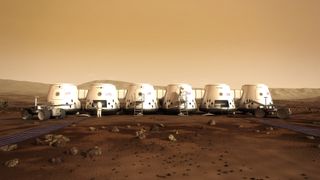
A group that's looking for the first Red Planet colonists received applications from more than 200,000 prospective astronauts vying for a spot on a one-way trip to Mars.
The non-profit Mars One Foundation hopes to send teams of four spaceflyers on one-way Mars colony missions starting in 2023. Its initial 19-week application window closed on Aug. 31, with a final tally of 202,586 volunteers.
The applicant pool is quite diverse with more than 140 countries represented, Mars One said in a statement. Nearly a quarter of the aspiring Mars colonists are from the United States. Ten percent of the applicants are Indians, the second largest group in the pool.

Mars One , based in the Netherlands, will face some major technical and funding challenges in the years ahead. It has not yet picked a spacecraft or rocket for the long voyage. The project also estimated it will cost about $6 billion to send its first crew to the Red Planet and $4 billion for each of the following missions.
The group started raising money through its application fees, which ranged from $5 to $75 depending on the applicant's country of origin. Mars One also hopes it will be able to raise funds with a reality TV show tracking the astronaut selection process and training.
Martian hopefuls who missed the deadline or were too young to apply this time around will have future chances to be considered. Mars One says it will start regular recruitment programs as the search for future Red Planet crews continues.
Follow Megan Gannon on Twitter and Google+ . Follow us @SPACEdotcom , Facebook or Google+ . Originally published on SPACE.com .

Get the Space.com Newsletter
Breaking space news, the latest updates on rocket launches, skywatching events and more!
Join our Space Forums to keep talking space on the latest missions, night sky and more! And if you have a news tip, correction or comment, let us know at: [email protected].

Megan has been writing for Live Science and Space.com since 2012. Her interests range from archaeology to space exploration, and she has a bachelor's degree in English and art history from New York University. Megan spent two years as a reporter on the national desk at NewsCore. She has watched dinosaur auctions, witnessed rocket launches, licked ancient pottery sherds in Cyprus and flown in zero gravity on a Zero Gravity Corp. to follow students sparking weightless fires for science. Follow her on Twitter for her latest project.
Virgin Galactic to launch 7th commercial spaceflight on June 8
China launches Chang'e 6 sample-return mission to moon's far side (video)
Boeing Starliner rolls out to launch pad for 1st astronaut flight on May 6 (photos)
Most Popular
- 2 The history of the Jedi Order in 'Star Wars'
- 3 Star Wars Day 2024: 'Star Wars: Tales of the Empire' premieres today on Disney+
- 4 Free Comic Book Day 2024: Get Marvel Comics 'Star Wars #1' for free
- 5 This Week In Space podcast: Episode 109 — Music of the Spheres
Watch CBS News
4 volunteers just entered a virtual "Mars" made by NASA. They won't come back for one year.
By Emily Mae Czachor
June 26, 2023 / 11:50 AM EDT / CBS News
Four volunteers entered a simulated Mars habitat on Sunday, where they are expected to remain for 378 days while facing a range of challenges designed to anticipate a real-life human mission to the red planet.
The participants — research scientist Kelly Haston, structural engineer Ross Brockwell, emergency medicine physician Nathan Jones and U.S. Navy microbiologist Anca Selariu — were selected from a pool of applicants to be part of NASA's Crew Health and Performance Exploration Analog, or CHAPEA, in its first yearlong mission. None of them are trained astronauts.
"Thank you all for your dedication to exploration," said Grace Douglas, the mission's principal investigator at NASA, during a briefing Sunday before they entered the habitat. "Our best wishes go with you."
Haston, designated by NASA as the commander of the simulated Mars mission, shared emotional remarks at the briefing about the importance of spaceflight and exploration, which she said "exemplifies some of the best qualities of humankind." Haston also praised fellow crew members, calling them an "amazing group of dedicated individuals who feel very passionate about space exploration and science."
"The crew has worked so hard this month to get ready for this mission," Haston said. "It has been very special to be a part of such a tremendous group of scientists and specialists from a diverse set of backgrounds working together to bring CHAPEA 1, the first of three missions, to reality."
Haston, Brockwell, Jones and Selariu will spend more than a year living and working in a simulated Mars environment built at the Johnson Space Center in Houston, Texas.
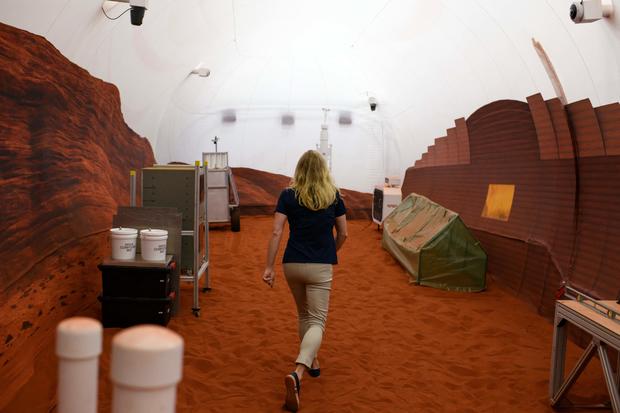
During their time inside of the 3D-printed, 1,700-square-foot habitat, the crew is set to carry out an array of "mission activities," including simulated spacewalks, robotic operations, growing of crops, habitat maintenance, personal hygiene and exercise, according to NASA . At 1,700 square feet, the habitat is smaller than the average U.S. single-family house. It includes a kitchen, private crew quarters and two bathrooms, along with medical, work and recreation areas.
They crew will also face a series of obstacles that likely mirror those of a true Mars mission, as researchers simulate conditions like resource limitations, equipment failure, communication delays and environmental stressors, NASA said in a news release when it introduced the crew members in April.
"The simulation will allow us to collect cognitive and physical performance data to give us more insight into the potential impacts of long-duration missions to Mars on crew health and performance," Douglas said at that time. "Ultimately, this information will help NASA make informed decisions to design and plan for a successful human mission to Mars."
The simulated mission is the first of three planned Mars surface simulations, each of which is expected to last one year. NASA says the information collected and studied over the course of these missions, along with ongoing exploration happening on and around the moon, will help send the first astronauts to Mars in the future.
Emily Mae Czachor is a reporter and news editor at CBSNews.com. She covers breaking news, often focusing on crime and extreme weather. Emily Mae has previously written for outlets including the Los Angeles Times, BuzzFeed and Newsweek.
More from CBS News
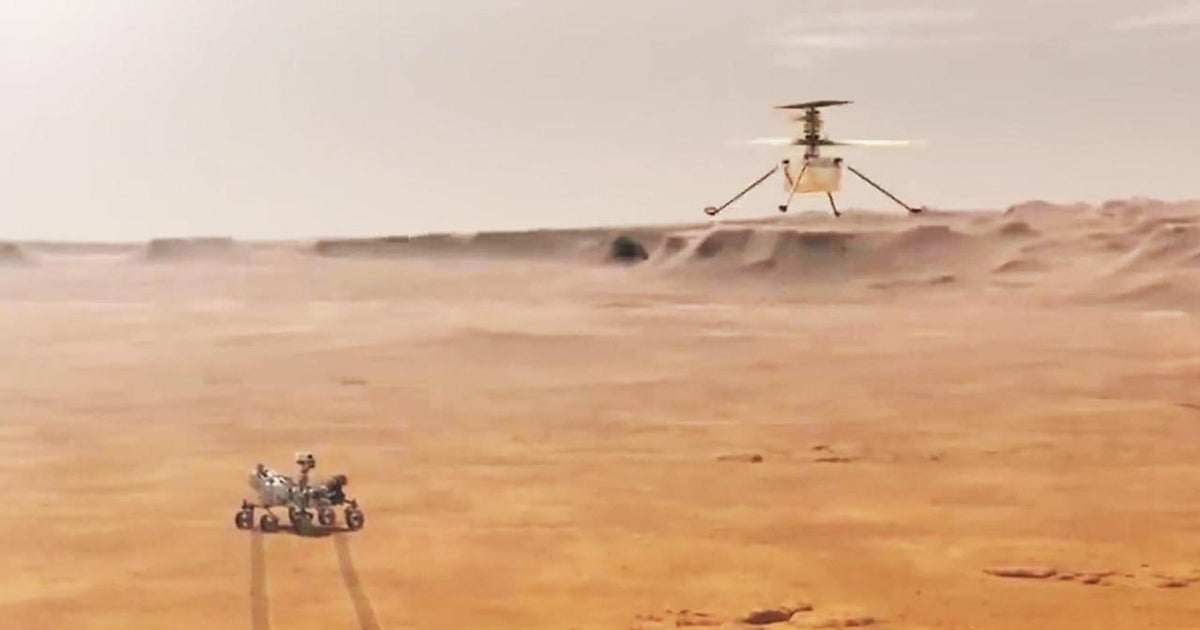
Ingenuity, NASA's "little 'copter that could" (and did!)

Boeing's Starliner spacecraft to lift off tonight on first piloted test flight

Boeing preps Starliner crew ferry ship for first piloted test flight
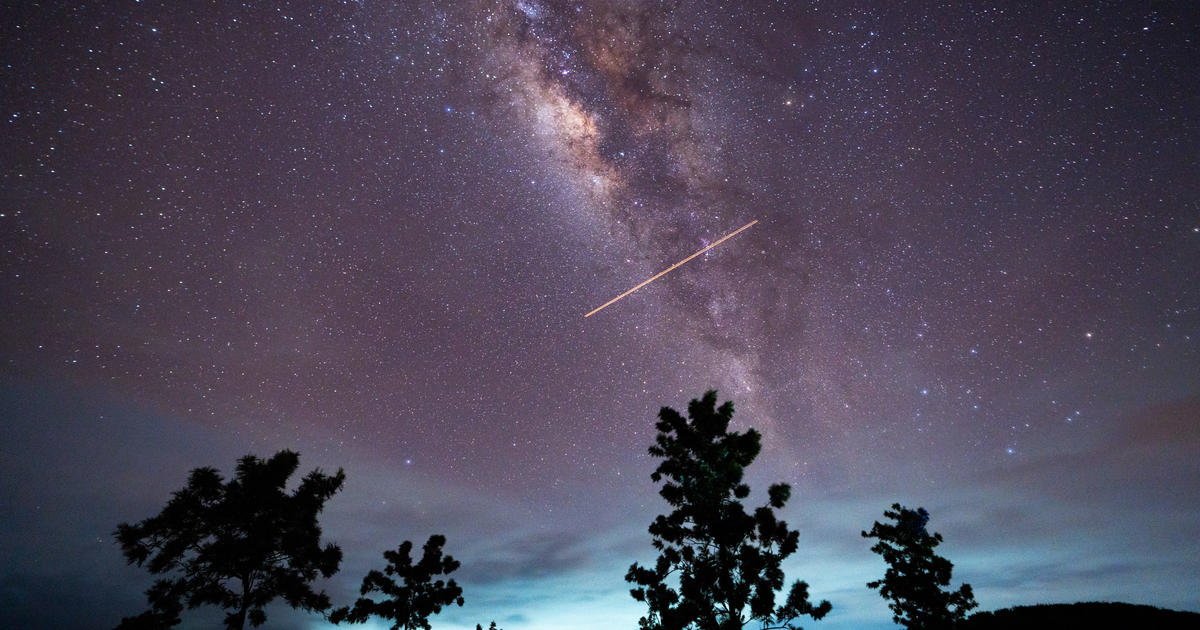
When and where you can see the Eta Aquariids meteor shower peak
It’s a wonderful world — and universe — out there.
Come explore with us!
Science News Explores
Four researchers on earth are spending a year on ‘mars’.
Locked in Mars Dune Alpha, they’ll test how visitors might handle life on the Red Planet
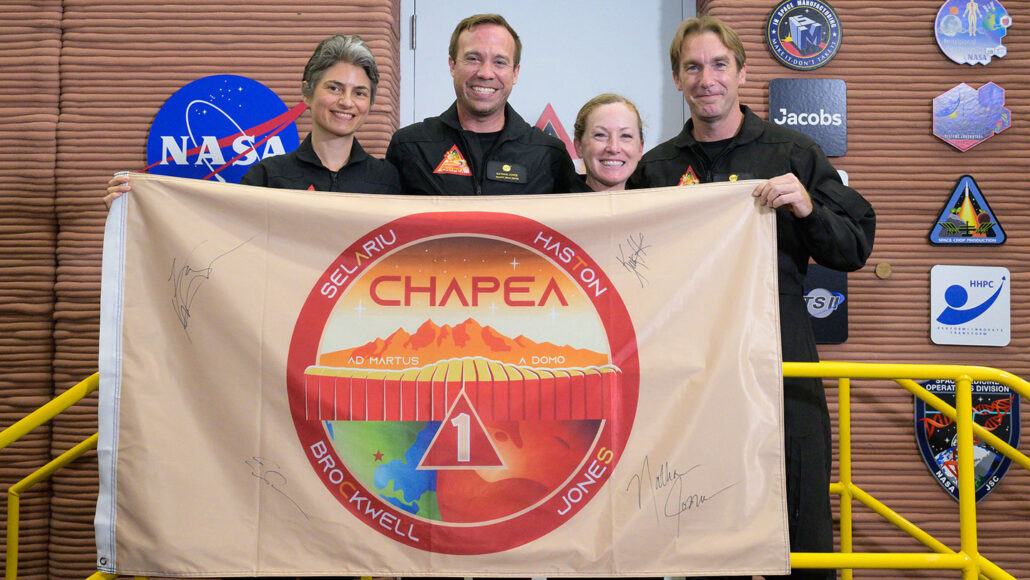
Here’s (from left) Anca Selariu, Nathan Jones, Kelly Haston and Ross Brockwell on June 25, 2023. They were about to enter Mars Dune Alpha (behind them). They’re due to stay inside it for more than a year, learning what it could be like to live on the Red Planet.
Josh Valcarcel/NASA
Share this:
- Google Classroom
By Payal Dhar
October 3, 2023 at 6:30 am
Listen to this story:
Have feedback on the audio version of this story? Let us know !
On June 25, four NASA recruits set off for to Mars — on Earth.
They embarked on the first of three year-long missions to prep Earthlings for life as extraterrestrials. But these missions are terrestrial.
This summer, the first crew of four volunteers entered a unique structure called Mars Dune Alpha. It’s located at NASA’s Johnson Space Center in Houston, Texas. The crew will stay inside it for a year. Their mission: to live and work as if they were on the Red Planet.
Visits two and three should start in 2025 and 2026. Each mission is being designed to prep astronauts for an actual stay on the Red Planet.
NASA plans to send a crew to Mars, possibly as early as 2040. Getting there will take a lot of work. High on the list will be getting the spaceships, landers, habitats and computers ready. But will people know how to survive on Mars?
That’s where a project known as Crew Health and Performance Exploration Analog — or CHAPEA — comes in. Its missions will monitor the physical and mental health of people as they spend long months in a place that’s as much like Mars as can be modeled on Earth. The volunteers’ experiences will help scientists, engineers and astronauts start to foresee what an actual trip to Mars will entail.
What the crews will face
CHAPEA will investigate how our health and ability to carry out tasks “alters when you’re working as if you’re on Mars,” explains Kelly Haston. A member of the Mohawk Nation and the Six Nations of the Grand River in Canada, she’s commanding this first mission. With a PhD in biomedicine, she’s used stem cells to study liver disease, reproduction and the nervous system.
Trained as a structural engineer, Ross Brockwell is her crew’s engineer. Nathan Jones, an emergency medicine physician, will serve as the in-house doctor. And Anca Selariu, the crew’s microbiologist, is a specialist in infectious diseases. She’s also an officer in the U.S. Navy.
Throughout a year in Mars Dune Alpha, this quartet “will face challenges,” Haston notes. Some “will be surprises to us,” she adds, “because they will be emergencies.” The crew was warned to expect periods of scarce food and water, equipment failures and excessive workloads.
Indeed, NASA designed this environment to be as stressful as living on Mars would likely be.
Even as they face these challenges, many of the crew’s conditions won’t be truly Martian. Earth’s gravity is about three times as strong as that on Mars. Radiation levels also are far lower than on Mars. And temps in Mars Dune Alpha will not be kept at Mars’ average of around -63º Celsius (-81º Fahrenheit). The Red Planet’s atmosphere is more than 95 percent carbon dioxide. Mars Dune Alpha’s crew will breathe Earth’s air; it’s 78 percent nitrogen and 21 percent oxygen. Earth’s air pressure is different, too — 100 times higher than on Mars.
Each trip to the Red Planet or home again could take more than a year. So astronauts truly on their way to Mars would spend long periods in isolation. Plus, spaceships are pretty tiny. Even crew dwellings on Mars will be quite small. Mars Dune Alpha was designed to reflect such tight quarters. The crew will spend every waking hour with the same few people.
During that time, though, they’ll be kept quite busy . Working in pairs, they’ll operate a helicopter-like drone and their own “Mars” rover. With these tools, they’ll survey remote areas. They’ll try to identify and retrieve rock samples. The volunteers also will take occasional “Marswalks” outside their habitat. They’ll do this in a 111 square meter (1,200 square foot) sandbox. It’s meant to simulate the Martian soil.
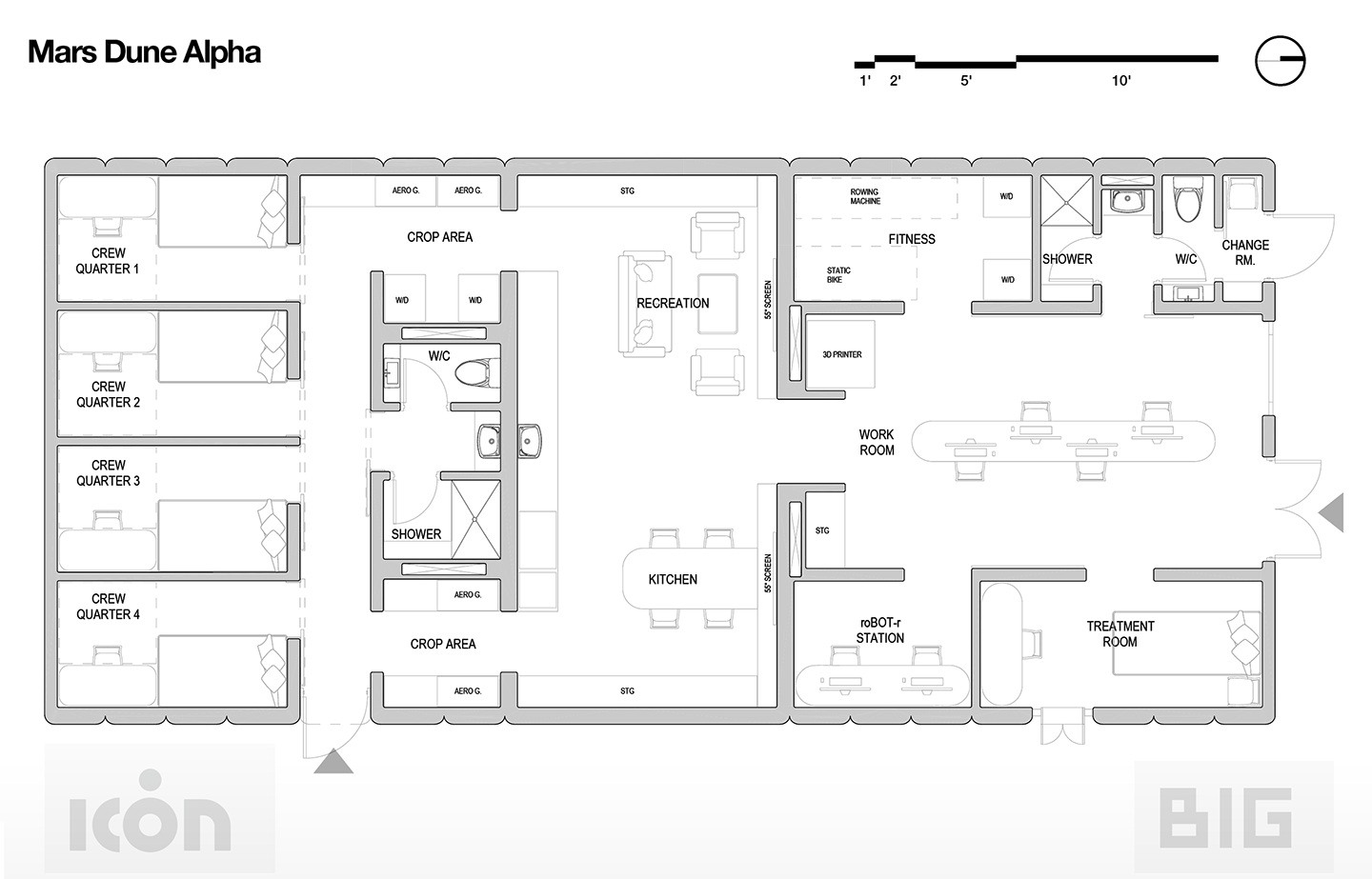
What Mars-on-Earth looks like
Mars Dune Alpha was 3-D printed. At 158 sq. meters (1,700 sq. ft.), it’s about the size of a three-bedroom apartment. There are four small living quarters and two bathrooms. There also are dedicated workstations, a medical area, a lounge and a galley. It would be too heavy to carry food from Earth, so astronauts going to Mars will have to produce their own. To prepare for that, the Mars Dune Alpha crew will grow its food in a vertical farm .
Deep-space homes will need to be highly durable, resilient and safe, notes Melodie Yashar. She’s a space architect at ICON. It’s the construction firm that 3-D printed Mars Dune Alpha.
NASA hopes to 3-D print any buildings on Mars , using local materials. That way the space agency won’t have to launch entire structures from Earth. With 3-D printing, “we can create a variety of structures” on the moon or some planet, “using the materials already present,” Yashar says. Those materials likely include the red Martian soil. ICON used its own “ink” to print Mars Dune Alpha. Called Lavacrete, this structural ink has been tinted red to appear Mars-like.
The printer didn’t have to cope with the atmosphere, gravity and radiation present on Mars, Yashar notes. But designing a Mars-on-Earth habitat was not unlike ICON’s projects for other isolated Earth environments. (They’ve worked on expeditions to Antarctica and deep-dive submarines.)
“With limited opportunities for resupply or evacuation, we design in a way that astronauts can be self-sufficient,” says Yashar. In space, there will be added environmental and health challenges. Those include microgravity , high radiation and extreme changes in temperature.
Educators and Parents, Sign Up for The Cheat Sheet
Weekly updates to help you use Science News Explores in the learning environment
Thank you for signing up!
There was a problem signing you up.
Living in isolation
To keep it as real as possible, Haston’s crew will have no immediate contact with their families. If they really were on Mars, it would take anywhere from three to 20 minutes to transmit data to and from Earth. So the crew will also experience a similar communications delay with Mission Control, despite it being just a short distance away.
And of course, Haston adds, “We have no one to call on if the toilet breaks.” So her crew will be expected to do any maintenance in the habitat.
Her crew won’t be the astronauts that NASA finally sends to Mars. But Haston says she feels “blessed” to be a small part of making that future mission possible.
“I’m a scientist, and I love challenges,” she says. “So this is the best of both worlds for me — to be a scientist and also a test subject at the same time. I’m giving back data to this effort in a unique way.”
More Stories from Science News Explores on Space

Check out the magnetic fields around our galaxy’s central black hole

Did James Webb telescope images ‘break’ the universe?
Explainer: what is the solar cycle.

Scientists Say: Corona

Get ready for the 2024 total solar eclipse

Let’s learn about meteorites

Scientists Say: Solar Cycle

The weird sky glow called STEVE is really confusing scientists
The Mars Society is a volunteer-driven non-profit organization dedicated to the exploration of the Red Planet. The group’s management and staff are all dedicated volunteers working towards the goal of an eventual humans-to-Mars mission and human settlement of the planet Mars.
Please see below for a current list of the Mars Society’s volunteer opportunities.
Annual Convention Volunteers
The Mars Society need assistance to organize and staff our annual international convention. Please contact our Convention Staff for more details on how you can join our volunteer team.
Mars Desert Research Station
Every year from October through May, the MDRS station has a crewed field season. MDRS management needs assistance with various tasks which can be done remotely. Please click here for the MDRS Volunteer Opportunities Call to Action .
Graphics Design & Production
The Mars Society is seeking skilled graphics designers for creating promotional brochures and web graphics as part of its public relations and fundraising efforts. Volunteers with previous experience with graphic design and use of programs like Adobe Photoshop for creating digital graphics should please contact the organization .
Information Technology (IT)
Contact our Executive Director James Burk for more information on technical IT volunteer opportunities.
Social Media Outreach
The Mars Society’s continuing campaign to better educate the public, the media and government about the importance of humans to Mars focuses to a great extent on social media. If you have a proven background in social media outreach and would like to help, please contact Michael Stoltz , Director of Media & Public Relations, to discuss a variety of volunteer opportunities.
Other Skills
If you possess some other relevant skill-set which is not indicated by the opportunities listed above, please do not hesitate to contact us to express your interest in volunteering for the Mars Society.
Going to Mars ... on a one-way trip
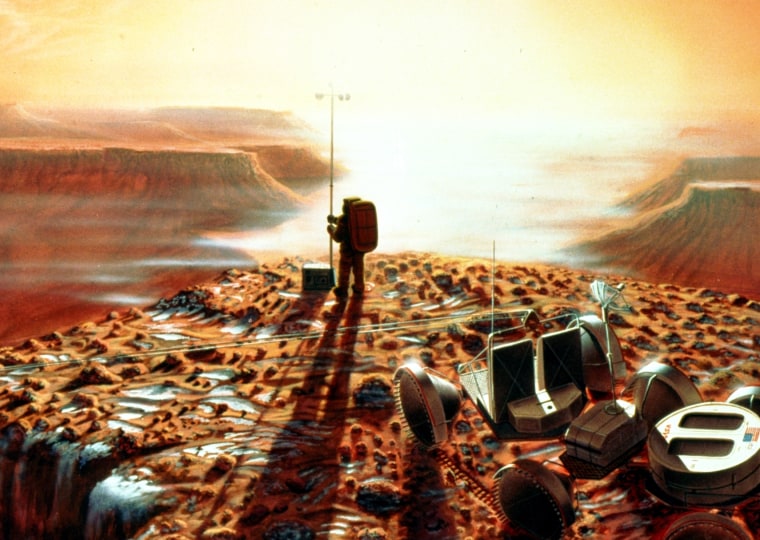
Will the first explorers to visit Mars come back to Earth? Or does it actually make more sense to leave them there? The idea of sending the Red Planet's first settlers on one-way trips has been kicking around for years, and now two researchers have published a paper in the Journal of Cosmology laying out how such missions could play out between now and 2035.
"It is important to realize that this is not a 'suicide mission,'" Washington State University's Dirk Schulze-Makuch and Arizona State University's Paul Davies write. "The astronauts would go to Mars with the intention of staying for the rest of their lives, as trailblazers of a permanent human Mars colony."
In a WSU news release , Davies said the concept follows the model set by past human settlements of new lands. "It would really be little different from the first white settlers of the North American continent, who left Europe with little expectation of return," he said.
Back in the mid-1990s, rocket scientist and Mars Society founder Robert Zubrin pointed out that "colonization is, by definition, a one-way trip," and since then experts have debated the best way to do one-way. Four years ago, X Prize co-founder Peter Diamandis suggested setting up a private-sector "Mars Citizenship Program," with volunteers kicking in from $10,000 to $1 million each, About 100 candidates would be chosen by lottery to take the trip to a Red Planet colony prepared for them by robots. (Scroll down through this Cosmic Log archive for details, plus reader reaction.)
Davies' colleague at ASU, theoretical physicist Lawrence Krauss, caused a stir last year by reviving the idea of one-way trips to Mars. Because much of the anticipated cost of a voyage to Mars was wrapped up in getting the voyagers back home again, eliminating the return trip would make the mission much more affordable. What's more, he suggested that the Mars voyagers might not be fit enough to make the return trip, due to radiation exposure. "As cruel as it may sound, the astronauts would probably best use their remaining time living and working on Mars rather than dying at home," Krauss wrote in his New York Times op-ed.
Schulze-Makuch and Davies don't think life on Mars would be so bad, judging by the scenario they lay out:
- First, robots would identify a suitable location for a colony, based on the availability of a natural shelter (such as a lava tube cave) and the availability of water (in the form of ice, of course) as well as minerals and nutrients. Robo-construction crews could make the place habitable for humans.
- The first one-way missions might involved two spaceships, each with a two-person crew. One of the astronauts should be a trained physician, and all of them should have scientific and technical know-how as well as a passion for research and exploration.
- Those first colonists should be beyond reproductive age, due to the concerns about radiation as well as reduced life expectancy in a frontier environment.
With time, a series of cave-centered biospheres could be built for the growing Martian community, with beefed-up radiation protection. "Probably several decades after the first human mission, the colony's population might have expanded to about 150 individuals, which would constitute a viable gene pool to allow the possibility of a successful long-term reproduction program," the researchers write. "New arrivees and possibly the use of genetic engineering would further enhance genetic variety and contribute to the health and longevity of the colonists."
Schulze-Makuch and Davies say the Mars colony would provide a long-term base for exploring the Red Planet and looking for traces of ancient or extant life. It would serve as an insurance policy for the species, just in case a killer asteroid or a killer virus endangered life on Earth. And it also could "offer a springboard for human/robotic exploration of the outer solar system and the asteroid belt."
The researchers don't delve into the costs or the detailed logistics for one-way missions, but they do note that NASA's space vision calls for just the kinds of heavy-lift rockets and robotic capabilities that would mesh with future voyages to Mars . "We estimate that a reasonable time line for establishing a permanent unmanned base with robots would be 20 years, with the first human contingent arriving shortly thereafter," they write. "The main impediment is the narrow vision and the culture of political caution that now pervades the space programs of most nations."
Would you agree? Or would it be even tougher to find intelligent, healthy volunteers willing to spend the rest of their lives on a frozen, radiation-blasted world? Whenever we've posed this question before, a fair number of people say they'd definitely go. Four years ago, 374 of the 1,169 msnbc.com users who responded to a Live Vote said they'd be willing to "pay a substantial price" for a one-way trip, assuming that the risk was acceptable. This time around, I'd love to hear your reasons for taking the one-way trip. (Or not taking it!) Just leave a comment below.
Connect with the Cosmic Log community by "liking" the log's Facebook page or following @b0yle on Twitter . You can also check out "The Case for Pluto," Alan's book about the controversial dwarf planet and the search for new worlds.
How to apply for NASA’s next Mars habitat simulation
See if you qualify to be a volunteer for a yearlong stint.
By Andrew Paul | Published Feb 16, 2024 4:00 PM EST

Looking for a change of pace from your day-to-day routine? Life on Earth feeling a bit overwhelming at the moment? How about a one-year residency alongside three strangers at a 3D-printed Mars habitat simulation?
On Friday, NASA announced it is now accepting applications for the second of three missions in its ongoing Crew Health and Performance Analog (CHAPEA) experiment. For 12 months, a quartet of volunteers will reside within Mars Dune Alpha , a 1,700-square-foot residence based at the Johnson Space Center in Houston, Texas, where they can expect to experience “resource limitations, equipment failures, communication delays, and other environmental stressors.”
[Related: To create a small Mars colony, leave the jerks on Earth .]
When not pretending to fight for your survival on a harsh, barren Martian landscape, CHAPEA team members will also conduct virtual reality spacewalk simulations, perform routine maintenance on the Mars Dune Alpha structure itself, oversee robotic operations, and grown their own crops, all while staying in shape through regular exercise regimens.
But if the thought of pretending to reside 300 million miles away from your current home sounds appealing, well… cool your jets. NASA makes it clear that there are a few requirements applicants must meet before being considered for the jobs—such as a master’s degree in a STEM field like engineering, computer science, or mathematics. Then you’ll need either two years professional experience in a related field, or a minimum of 1,000 hours spent piloting aircrafts. Also, only non-smokers between 30 and 55-years-old will be considered, and military experience certainly sounds like a plus.
Oh, and you’ll also need to fill out NASA’s lengthy questionnaire, which includes entries like, “Are you willing to have no communication outside of your crew without a minimum time delay of 20 minutes for extended periods (up to one year)?” and, “Are you willing to consume processed, shelf-stable spaceflight foods for a year with no input into the menu?”
It’s certainly a lot to consider. But as tough as it might be, simulations like CHAPEA are vital for NASA’s Artemis plans to establish a permanent human presence on both the moon and Mars. The truly intrepid and accomplished among you have until April 2 to fill out the official application . Seeing as how CHAPEA’s inaugural class is currently about halfway through their one-year stint, this second round of volunteers won’t need to report for duty until sometime in 2025.

Andrew Paul is Popular Science's staff writer covering tech news. Previously, he was a regular contributor to The A.V. Club and Input, and has had recent work also featured by Rolling Stone, Fangoria, GQ, Slate, NBC, as well as McSweeney's Internet Tendency. He lives outside Indianapolis.
Like science, tech, and DIY projects?
Sign up to receive Popular Science's emails and get the highlights.
NASA seeks volunteers for a paid, yearlong simulated Mars mission
The mission will last 378 days and is set to begin in Spring 2025.
The future of Mars exploration is on the horizon and NASA is recruiting citizen volunteers to help make that future a reality.
NASA is recruiting qualified individuals to participate in a yearlong mission on a simulated version of the Red Planet, the agency announced this week .
The volunteers will live and work at the Johnson Space Center in Houston, inside Mars Dune Alpha, a 1,700-square-foot, 3D-printed habitat.

"For the explorers, the adventurers, the people who love science, this is a really unique and incredible opportunity to be able to contribute to science," Suzanne Bell, lead for NASA's Behavioral Health and Performance Laboratory at Johnson Space Center, told ABC News.
MORE: NASA announces new 'super-Earth': Exoplanet orbits in 'habitable zone,' is only 137 light-years away
The mission, which is the second installment of three planned programs from the Crew Health and Performance Exploration Analog (CHAPEA), will last 378 days and is set to begin in Spring 2025.
"We mimic what we expect for a Mars habitat surface mission," Bell said. "We collect all sorts of data so we can learn how humans can survive and thrive in that circumstance."
The simulated Mars habitat will replicate the challenges of a mission in space. NASA says "resource limitations, equipment failures, communication delays, and other environmental stressors" will be a part of the mission.

Members of the four-person team can expect "simulated spacewalks, robotic operations, habitat maintenance, exercise, and crop growth," according to the agency.
"Applicants should have a strong desire for unique, rewarding adventures and interest in contributing to NASA's work to prepare for the first human journey to Mars," the agency said in a press release Friday .
Related Stories

Vehicle crashes into White House gate, killing 1
- May 5, 2:53 AM

10-month-old baby has been found: Officials
- May 6, 11:05 AM

Man kills wife, 3 kids in mass shooting: Police
- Apr 23, 12:35 PM
The current CHAPEA mission is on its 242nd day out of 378, according to Bell, who notes, "We are learning from this crew and collecting data every day."
Bell says the three missions are designed to eliminate the "anomaly of a particular crew or individuals."
"We're seeing how we can best support people in the circumstances for their human health. We're starting to see trends that we could interpret to best support people of the future," Bell explained.
MORE: How NASA’s PACE mission hopes to examine oceanic and atmospheric mysteries
To qualify for the mission, you must be a healthy, nonsmoking U.S. citizen or a permanent resident between the ages of 30 and 55 years old and proficient in English.
The agency says applicants must have a master's degree with STEM qualifications and experience in the field, or a minimum of 1,000 hours piloting an aircraft or the requisite military experience. A bachelor of science degree in a STEM field also may be considered, NASA said.
"What we are looking for in this call is everyday civilians who are very astronaut-like to be research participants for us," Bell said.
Compensation for participating in the mission is available, according to NASA, but an exact salary will be provided during the candidate screening process.
The deadline to apply is April 2 on NASA's CHAPEA website .
Related Topics

6 months out, a tight presidential race: POLL
- May 5, 7:12 AM
Ex-Fulton County Prosecutor Nathan Wade speaks out
- May 5, 5:29 PM
ABC News Live
24/7 coverage of breaking news and live events
- International edition
- Australia edition
- Europe edition


A year out of this world: Nasa seeks volunteers to simulate Mars mission
Four-person crew will inhabit 3D-printed replica of red planet to help develop and evaluate systems for missions slated for 2030s
For anybody already jaded by the news and joking about a trip to outer space to avoid it all, Nasa might just have you covered.
The space agency is seeking four volunteers to spend a year living on Mars – or at least a 3D-printed replica of the red planet. Isolation is pretty much guaranteed.
The venture, at its Johnson Space Center in Houston, is part of Nasa’s Chapea (crew health and performance exploration analog) program, which is designed to help develop and evaluate the systems that will be used by the first generation of astronauts to visit Mars, on missions ambitiously slated for the 2030s.
The agency says the volunteers will be living in a 1,700 sq ft habitat called Mars Dune Alpha , which will simulate the challenges of a Mars mission, “including resource limitations, equipment failures, communication delays, and other environmental stressors”.
The crew will undertake simulated spacewalks, robotic operations, habitat maintenance, exercise, and crop growth in the computer-generated reconstruction of the Martian surface.
Those selected will be compensated for their time, though Nasa does not say how much. Mission managers are focused on securing the right mix of candidates, and insist anybody who applies must have a university degree in engineering, mathematics, or biological, physical or computer science, and subsequent experience in those fields, or 1,000 hours as a pilot.
They also have to be healthy, non-smoking US citizens or permanent residents aged 30 to 55.
“Applicants should have a strong desire for unique, rewarding adventures and interest in contributing to Nasa’s work to prepare for the first human journey to Mars,” the agency said. Applications close on 2 April.
After training, the crew will become the second to live in the habitat from early next year. The four members of the Chapea 1 mission currently resident are scheduled to leave in August after a 378-day expedition that began last summer.
Most viewed

Suggested Searches
- Climate Change
- Expedition 64
- Mars perseverance
- SpaceX Crew-2
- International Space Station
- View All Topics A-Z
Humans in Space
Earth & climate, the solar system, the universe, aeronautics, learning resources, news & events.

NASA’s Commercial Partners Deliver Cargo, Crew for Station Science

Hi-C Rocket Experiment Achieves Never-Before-Seen Look at Solar Flares

NASA Is Helping Protect Tigers, Jaguars, and Elephants. Here’s How.
- Search All NASA Missions
- A to Z List of Missions
- Upcoming Launches and Landings
- Spaceships and Rockets
- Communicating with Missions
- James Webb Space Telescope
- Hubble Space Telescope
- Why Go to Space
- Astronauts Home
- Commercial Space
- Destinations
Living in Space
- Explore Earth Science
- Earth, Our Planet
- Earth Science in Action
- Earth Multimedia
- Earth Science Researchers
- Pluto & Dwarf Planets
- Asteroids, Comets & Meteors
- The Kuiper Belt
- The Oort Cloud
- Skywatching
- The Search for Life in the Universe
- Black Holes
- The Big Bang
- Dark Energy & Dark Matter
- Earth Science
- Planetary Science
- Astrophysics & Space Science
- The Sun & Heliophysics
- Biological & Physical Sciences
- Lunar Science
- Citizen Science
- Astromaterials
- Aeronautics Research
- Human Space Travel Research
- Science in the Air
- NASA Aircraft
- Flight Innovation
- Supersonic Flight
- Air Traffic Solutions
- Green Aviation Tech
- Drones & You
- Technology Transfer & Spinoffs
- Space Travel Technology
- Technology Living in Space
- Manufacturing and Materials
- Science Instruments
- For Kids and Students
- For Educators
- For Colleges and Universities
- For Professionals
- Science for Everyone
- Requests for Exhibits, Artifacts, or Speakers
- STEM Engagement at NASA
- NASA's Impacts
- Centers and Facilities
- Directorates
- Organizations
- People of NASA
- Internships
- Our History
- Doing Business with NASA
- Get Involved
- Aeronáutica
- Ciencias Terrestres
- Sistema Solar
- All NASA News
- Video Series on NASA+
- Newsletters
- Social Media
- Media Resources
- Upcoming Launches & Landings
- Virtual Events
- Sounds and Ringtones
- Interactives
- STEM Multimedia

C.26 Rapid Mission Design Studies for Mars Sample Return Correction and Other Documents Posted

Hubble Views a Galaxy with a Voracious Black Hole

Hubble Hunts Visible Light Sources of X-Rays

NASA Mission Strengthens 40-Year Friendship

NASA Selects Commercial Service Studies to Enable Mars Robotic Science

Two Small NASA Satellites Will Measure Soil Moisture, Volcanic Gases

NASA-Led Study Provides New Global Accounting of Earth’s Rivers

NASA Selects Students for Europa Clipper Intern Program

Orbits and Kepler’s Laws

New NASA Black Hole Visualization Takes Viewers Beyond the Brink

Black Hole Week

The Big Event, 2024

ARMD Solicitations

NASA’s Commitment to Safety Starts with its Culture

NASA Uses Small Engine to Enhance Sustainable Jet Research

Tech Today: NASA’s Ion Thruster Knowhow Keeps Satellites Flying

Big Science Drives Wallops’ Upgrades for NASA Suborbital Missions

NASA Community College Aerospace Scholars

NASA Grant Brings Students at Underserved Institutions to the Stars

Asian-American and Native Hawaiian Pacific Islander Heritage Month

Diez maneras en que los estudiantes pueden prepararse para ser astronautas

Astronauta de la NASA Marcos Berríos

Resultados científicos revolucionarios en la estación espacial de 2023
Nasa selects new crew for next simulated mars journey.
Nathan Cranford
Primary crew, alternate crew, complementary analog missions.

Lee esta historia en español aquí .
NASA has selected a new crew of four volunteers to participate in a simulated mission to Mars within a habitat at the agency’s Johnson Space Center in Houston.
Jason Lee, Stephanie Navarro, Shareef Al Romaithi, and Piyumi Wijesekara will step into the agency’s Human Exploration Research Analog, or HERA , on Friday, May 10. Once inside, the team will live and work like astronauts for 45 days. The crew will exit the facility on June 24 after they “return” to Earth. Jose Baca and Brandon Kent are this mission’s alternate crew members.
HERA enables scientists to study how crew members adapt to isolation, confinement, and remote conditions before NASA sends astronauts on deep space missions to the Moon, Mars, and beyond. Crew members will carry out scientific research and operational tasks throughout their simulated mission to the Red Planet, including a “walk” on Mars’s surface using virtual reality. They will also experience increasing communication delays lasting up to five minutes each way with Mission Control Center as they “near” Mars.
This crew is the second group of volunteers to participate in a simulated Mars mission in HERA this year. The most recent crew completed its HERA mission on March 18. Two other missions will follow this year, with the final HERA crew slated to wrap up on Dec. 20.
In a first for HERA, one crew member, Shareef Al Romaithi, hails from the United Arab Emirates (UAE) and will participate in the mission through a partnership between NASA and the UAE’s Mohammed Bin Rashid Space Centre (MBRSC).
As with the previous HERA mission this year, NASA’s Human Research Program is conducting 18 human health studies during the mission. The experiments will evaluate the physiological, behavioral, and psychological responses of crew members in an environment similar to what astronauts will face on a trip to Mars. Seven of these studies are collaborations with the MBRSC and the European Space Agency (ESA). Insights gleaned from the studies will allow researchers to develop and test strategies aimed at helping astronauts overcome obstacles on long missions deep into space.
The primary crew of the upcoming mission is:

Lee holds a bachelor’s degree in Mechanical Engineering from the University of California, Berkeley and master’s and doctorate degrees in Mechanical Engineering from the University of Texas at Austin. His graduate research focused on manufacturing processes involving heat transfer and the characterization of heat shielding materials. He completed a postdoctoral degree at the Massachusetts Institute of Technology, Cambridge, studying high-strength nanofibers.
Lee lives in Boston. In his spare time, he enjoys running, martial arts, chess, and indoor rock climbing. He also likes to watch movies and plays, try new cuisines, spend time with friends, and visit his nephew and nieces.
Stephanie Navarro

Navarro earned her bachelor’s degree in Physics from the University of Central Florida in Orlando. While pursuing her undergraduate studies, she served the constituents of Florida as a congressional intern for both the U.S. House and Senate. She recently completed a model-based systems engineering certificate program from the California Institute of Technology, Pasadena, and is working toward a master’s degree in Cybersecurity from the University of Maryland Global Campus.
Born and raised by Ecuadorian parents in Miami, Navarro has strong ties to her cultural heritage. She enjoys spending time with her family, traveling the world, studying for her pilot’s license, and immersing herself in various culinary experiences. During her spare time, she is either working out, at the beach, or in the air flying a Cessna 172. She lives in Orlando, Florida.
Shareef Al Romaithi

Al Romaithi received a bachelor’s degree in Aerospace Engineering and three master’s degrees from Embry-Riddle Aeronautical University, focusing on aerospace and aviation management, safety systems, and space operations, respectively. He went on to earn a doctorate degree in Aviation from Embry-Riddle Aeronautical University in 2014, specializing in safety systems and human factors. These degrees were based at the university’s Dayton Beach campus, except for the master’s focusing on space operations, which was from the university’s worldwide campus. He is the world’s youngest and eighth graduate to attain a doctorate degree in aviation.
Al Romaithi currently lives in Abu Dhabi, UAE. He joins HERA through a partnership between NASA and MBRSC. In his free time, he enjoys fishing, reading, and traveling.
Piyumi Wijesekara

Wijesekara earned her bachelor’s degree in Bioengineering from the University of California, San Diego, and her master’s and doctorate degrees in Biomedical Engineering from Carnegie Mellon University in Pittsburgh, Penn. Her doctoral research focused on stem cell and organ engineering, with an emphasis on engineering lung models that mimic human lung physiology, to study respiratory diseases.
Wijesekara currently lives in San Francisco. She enjoys spending time with family and friends, running along the San Francisco Bay, reading, hiking, volunteering at the food pantry, and attending concerts and musicals.

Baca received a bachelor’s degree in Electrical Engineering from the Instituto Tecnologico de Matamoros in Mexico. He then earned a master’s degree in Mechatronics from the University of Applied Science of Aachen, Germany, and a doctorate degree in Automation and Robotics from the Universidad Politecnica in Madrid, Spain.
Baca went on to work as a postdoctoral researcher in the computer science department at the University of Nebraska at Omaha. There, he became involved in a research project funded by NASA that sought to develop a reconfigurable robotic system capable of transforming itself to overcome obstacles and explore unknown scenarios. Through this work, he also began undertaking projects aimed at supporting astronauts during long-duration space missions.
In his free time, Baca promotes science, technology, engineering, and math activities for students in elementary school through college, with a particular focus on engineering and robotics. He lives in Corpus Christi, Texas and enjoys exercising, exploring new places, experiencing new cultures and cuisines, and spending time with family.
Brandon Kent

Kent holds bachelor’s degrees in both Biochemistry and Biology from North Carolina State University in Raleigh. He earned his doctorate in Biomedicine from Mount Sinai School of Medicine in New York City, where his work primarily focused on how genetic factors regulate early embryonic development and cancer development.
Following graduate school, Kent moved into scientific and medical communications consulting in oncology, with a primary focus on clinical trial data disclosures, scientific exchange, and medical education initiatives.
Kent and his wife have two daughters. In his spare time, he enjoys spending time with his daughters, flying private aircraft, hiking, staying physically fit, and reading. He lives in Kinnelon, New Jersey.
In addition to HERA, NASA’s Crew Health and Performance Exploration Analog (CHAPEA ), a series of analog missions that will simulate year-long stays on the surface of Mars, is informing the agency’s efforts in preparing for future human Mars missions.
HERA and CHAPEA complement each other by assessing human health and performance in isolated and confined conditions that simulate spaceflight operations in the remote exploration environments of the Moon and Mars, including communication delays and environmental stressors. Both analogs collect data on humans living and working in separate habitats at NASA Johnson.
NASA’s Human Research Program
NASA’s Human Research Program , or HRP, pursues the best methods and technologies to support safe, productive human space travel. Through science conducted in laboratories, ground-based analogs, and the International Space Station, HRP scrutinizes how spaceflight affects human bodies and behaviors. Such research drives HRP’s quest to innovate ways that keep astronauts healthy and mission-ready as space travel expands to the Moon, Mars, and beyond.
Explore More
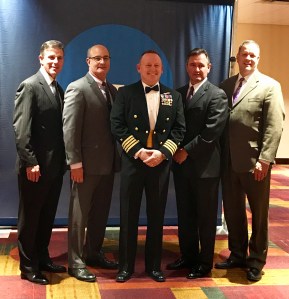
Discover More Topics From NASA
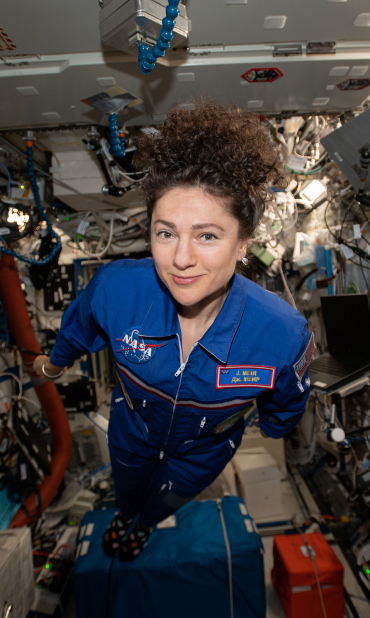
Human Research Program

Space Station Research and Technology

Na Ulitse Yalagina 13B Apartments

Property Policies
Frequently asked questions, how much does it cost to stay at na ulitse yalagina 13b apartments, what are the check-in and check-out times at na ulitse yalagina 13b apartments, does na ulitse yalagina 13b apartments provide airport transfer services, what amenities and services does na ulitse yalagina 13b apartments have, does na ulitse yalagina 13b apartments have a swimming pool, does na ulitse yalagina 13b apartments have fitness amenities, does na ulitse yalagina 13b apartments provide wi-fi, does na ulitse yalagina 13b apartments have non-smoking rooms, does na ulitse yalagina 13b apartments have a restaurant, is parking available at na ulitse yalagina 13b apartments, popular hotels, popular attractions, explore more.
View prices for your travel dates
- Excellent 6
- Very Good 11
- All languages ( 25 )
- Russian ( 25 )
- English ( 0 )
Own or manage this property? Claim your listing for free to respond to reviews, update your profile and much more.
ELEKTROSTAL HOTEL

IMAGES
COMMENTS
One-Way Mars Colony Project Draws 200,000 Volunteers. News. ... Red Planet colonists received applications from more than 200,000 prospective astronauts vying for a spot on a one-way trip to Mars.
Each CHAPEA mission involves a four-person volunteer crew living and working inside a 1,700-square-foot, 3D-printed habitat based at NASA's Johnson Space Center in Houston. The habitat, called the Mars Dune Alpha, simulates the challenges of a mission on Mars, including resource limitations, equipment failures, communication delays, and other ...
Here we explain about the mission, Mars spacecrafts and selecting volunteers to establish a colony on the planet Ian Sample , science editor Mon 9 Feb 2015 04.08 EST Last modified on Wed 14 Feb ...
By Tanya Lewis. WASHINGTON — A group of volunteers hoping to become the first human Martians congregated in one spot for the first time Saturday to discuss their hopes to join the Mars One ...
Four volunteers entered a simulated Mars habitat on Sunday, where they are expected to remain for 378 days while facing a range of challenges designed to anticipate a real-life human mission to ...
The volunteers' experiences will help scientists, engineers and astronauts start to foresee what an actual trip to Mars will entail. Take a look inside the 3-D printed habitat outside Houston, Texas. It will house four volunteers for the next year as they experience Mars-on-Earth.
NASA has selected a crew of four for the next NASA's Human Exploration Research Analog mission, a simulated mission to Mars. From left are Kamak Ebadi, Susan Hilbig, Abhishek Bhagat, and Carli Domenico. Credit: NASA. Editor's Note, Jan. 26, 2024: The crew roster for this HERA mission has been updated. NASA selected a crew of four volunteers ...
The Mars Society is a volunteer-driven non-profit organization dedicated to the exploration of the Red Planet. The group's management and staff are all dedicated volunteers working towards the goal of an eventual humans-to-Mars mission and human settlement of the planet Mars. Please see below for a current list of the Mars Society's volunteer opportunities. Annual Convention Volunteers The ...
Four years ago, X Prize co-founder Peter Diamandis suggested setting up a private-sector "Mars Citizenship Program," with volunteers kicking in from $10,000 to $1 million each, About 100 ...
For 12 months, a quartet of volunteers will reside within Mars Dune Alpha, a 1,700-square-foot residence based at the Johnson Space Center in Houston, Texas, where they can expect to experience ...
NASA is recruiting qualified individuals to participate in a yearlong mission on a simulated version of the Red Planet, the agency announced this week. The volunteers will live and work at the ...
A year out of this world: Nasa seeks volunteers to simulate Mars mission. Four-person crew will inhabit 3D-printed replica of red planet to help develop and evaluate systems for missions slated ...
NASA has a new Mars mission: seeking volunteers to spend an entire year living in a simulated version of the red planet.. Why it matters: The surface mission on a 3D-printed habitat, called the Mars Dune Alpha, will help inform the agency's plans for human exploration of the planet, per a statement from NASA. Photo: NASA/X The big picture: The second of three planned ground-based missions ...
NASA has selected a new crew of four volunteers to participate in a simulated mission to Mars within a habitat at the agency's Johnson Space Center in Houston.. Jason Lee, Stephanie Navarro, Shareef Al Romaithi, and Piyumi Wijesekara will step into the agency's Human Exploration Research Analog, or HERA, on Friday, May 10.Once inside, the team will live and work like astronauts for 45 days.
Updated: Feb 20, 2024 / 02:54 PM CST. ( NewsNation) — NASA is looking for volunteers to take part in a yearlong Mars simulation, living in an environment designed to mimic the red planet. Applicants will compete for a spot to live in Mars Dune Alpha, a 1,700-square-foot, 3D-printed habitat based at NASA's Johnson Space Center in Houston.
Best Dining in Elektrostal, Moscow Oblast: See 603 Tripadvisor traveler reviews of 37 Elektrostal restaurants and search by cuisine, price, location, and more.
Art MuseumsHistory Museums. Write a review. Full view. All photos (22) Suggest edits to improve what we show. Improve this listing. The area. Nikolaeva ul., d. 30A, Elektrostal 144003 Russia. Reach out directly.
Na Ulitse Yalagina 13B Apartments. Region, Elektrostal, ulitsa Yalagina, 13Б, Elektrostal', Moscow region, Russia. LocationIf you want to feel like you're at home no matter where you are, choose this — apartment «Na Ulitse Yalagina 13A Apartments» is located in Elektrostal. This apartment is located in 3 km from the city center.
Elektrostal Hotel, Elektrostal: See 25 traveler reviews, 44 candid photos, and great deals for Elektrostal Hotel, ranked #1 of 2 B&Bs / inns in Elektrostal and rated 4 of 5 at Tripadvisor.